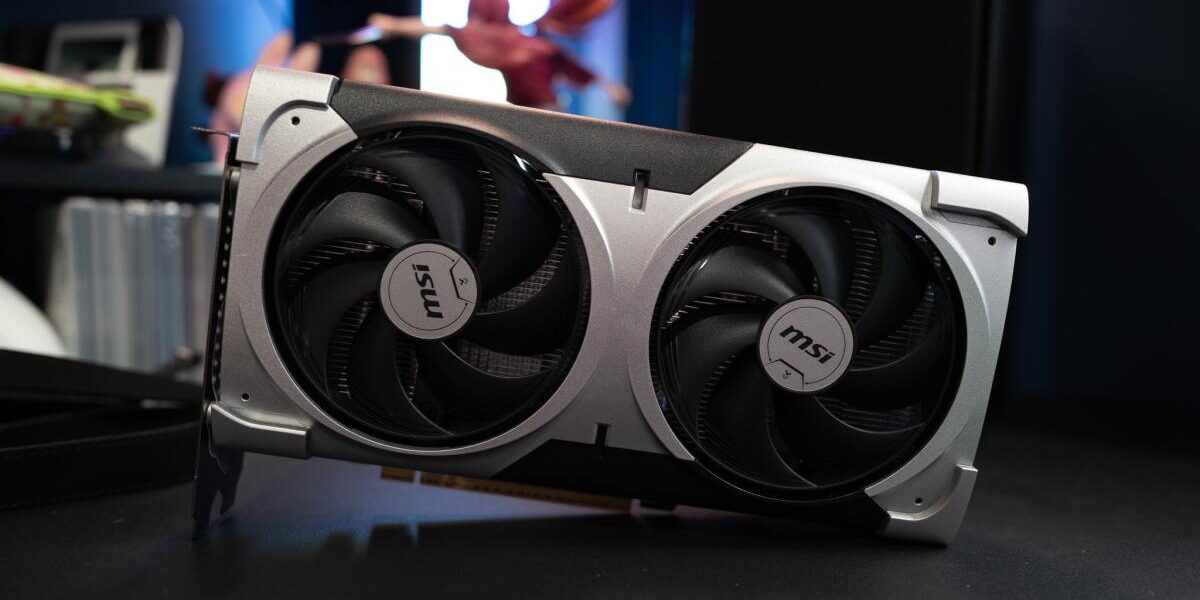NVIDIA GeForce RTX 5060 Ti (16GB) review: A solid GPU upgrade marred by uncertain pricing
NVIDIA GeForce RTX 5060 Ti (16GB) review: A solid GPU upgrade marred by uncertain pricing

NVIDIA’s GeForce RTX 50 series has certainly caught the attention of hardcore gamers and PC enthusiasts since its launch a few months ago – not only for its impressive performance but also due to ongoing scarcity and inflated prices well above recommended retail levels. The volatile global tariff situation doesn’t look set to ease these pricing pressures anytime soon too.
While it’s the flagship models like the RTX 5090 that understandably catches the most attention, it’s always the low- to mid-range GPUs that often strike a more relatable chord to the layman gamer. Enter the NVIDIA GeForce RTX 5060 Ti, which comes in either 8GB or 16GB of VRAM. In a media presentation, NVIDIA promises substantial performance improvements and a balance between cost and power consumption. On paper at least, this GPU could occupy the sweet spot of the market at US$379 (8GB) and US$429 (16GB). Of course, paying that price for mid-tier GPUs also just shows how much of a crazier world we live in now – but this will be a story for another day.


Launching alongside its trimmed-down 8GB counterpart, the 16GB model aims squarely at gamers who have grown wary of hitting VRAM limits in newer, graphically demanding titles. NVIDIA has equipped both RTX 5060 Ti variants with 4,608 CUDA cores, running at a base clock of 2,407MHz that boost comfortably up to 2,572MHz. It will also have a 128-bit memory bus that drives its GDDR7 memory, and like all of the RTX 50 series GPUs before it, the RTX 5060 Ti will also feature new techs like DLSS 4 and Multi Frame Generation.
| GeForce Graphics Card |
RTX 5090 | RTX 5080 | RTX 5070 Ti | RTX 5060 Ti | RTX 4060 Ti |
|---|---|---|---|---|---|
| GPU | Blackwell (GB202) | Blackwell (GB203) | Blackwell (GB203) | Blackwell (GB206) | Ada Lovelace (AD104) |
| Process | 4nm (TSMC) | 5nm (TSMC) | |||
| Transistors | 92 billion | 46 billion | 46 billion |
22 billion | 22 billion |
| Streaming Multi-processors (SM) | 170 | 84 | 70 | 36 | 34 |
| CUDA cores | 21760 | 10752 | 8960 | 4608 | 4352 |
| Tensor Cores | 680 (Gen 5) | 336 (Gen 5) | 280 (Gen 5) |
144 (Gen 5) | 136 (Gen 4) |
| RT Cores | 170 (Gen 4) | 84 (Gen 4) | 70 (Gen 4) |
36 (Gen 4) | 34 (Gen 3) |
| GPU base / boost clocks (MHz) | 2017 / 2407 | 2295 / 2617 | 2300 / 2452 | 2407 / 2572 | 2310 / 2535 |
| Memory | 32GB GDDR7 | 16GB GDDR7 | 16GB GDDR7 | 16GB GDDR7 / 8GB GDDR7 | 8GB GDDR6 |
| Memory bus width | 512-bit | 256-bit | 256-bit | 128-bit | 128-bit |
| Memory bandwidth | 1,790 GB/s | 960 GB/s | 896 GB/s | 448 GB/s | 288 GB/s |
| Interface | PCIe 5.0 | PCIe 4.0 | |||
| TDP | 575W | 360W | 300W | 180W | 160W |
| Price | US$1,999 | US$999 | US$749 | US$429 (16GB) / US$379 8GB) | US$399 |

The launch strategy here is a bit curious, though. By launching without its own Founders Edition (FE) model for the RTX 5060 Ti, NVIDIA won’t be able to impact AIB partners’ equivalent cards’ pricings. It boggles my mind, when you consider it did launch an FE for both the 3060 Ti and 4060 Ti. This choice will inevitably cast a slight shadow over availability and final costs, making the RTX 5060 Ti’s real-world value something I’ll be monitoring closely. Still, the blend of specs and NVIDIA’s typically persuasive performance claims create ample excitement around this GPU. The question now is whether it lives up to these ambitious promises—or if compromises were quietly made in pursuit of affordability. Let’s find out.
HWZ Test rig specifications

Our updated test rig comes with the following specifications:
For this review, my focus will be the RTX 5060 Ti (16GB)’s performance against its direct predecessor, the RTX 4060 Ti (8GB). But numbers from previously benchmarked GPUs from the rest of the RTX 50 series as well as AMD’s Radeon RX 9070 series are also included, so as to give us an idea of where the RTX 5060 Ti’s performance stands in the RTX 50 series’ stack.
Gaming performance (rasterization)
My game list includes a mixture of old and recent games to test the RTX 5070 Ti’s performance, and while the list isn’t exhaustive by any measure there are enough different game engines and APIs variety to give us an idea of broader performance trends.




In rasterization performance, the RTX 5060 Ti card delivers some pretty impressive results at both 1080p and 1440p with all the visual settings maxed out, completely outclassing the RTX 4060 Ti – in huge part thanks to the superior 16GB of GDDR7 VRAM. That additional memory count also allowed the RTX 5060 Ti to squeak in some decent performances at 4K too, for some games. For more power-hungry games, turning on DLSS 4 is how the RTX 5060 Ti truly soar.
Cyberpunk 2077 is one of the earliest game to fully support DLSS 4 and Multi Frame Generation and is a great test title, as it demonstrates the motion clarity improvements with higher frame rates that NVIDIA’s new technique brings to the RTX 50 Series.
DLSS 4 and ray tracing



As we can see in the charts above, at higher resolutions like 4K with full settings switched on, the RTX 5060 Ti becomes more playable once Frame Generation is activated and reaches up to 114fps . But with 3x Multi Frame Generation, the game’s framerate jumped to an even smoother 163fps. Of course, the caveat here is that the 163 frames may not feel “real” for those with more discerning hand-eye coordinations, because the game still maintains the same input latency it has after DLSS is applied – so it’s less reactive than a real 163fps when you hit the mouse button to shoot.
Power and Temperature

The RTX 5060 Ti sports a modest 20W increase over its RTX 4060 Ti non-Super, but it’s worth noting how its thermal efficiency and gaming performance are still better than many of the RTX 50 series cards seen here.
Final thoughts
All things considered, NVIDIA’s GeForce RTX 5060 Ti (16GB) positions itself neatly in the mid-range GPU segment, delivering genuinely impressive leaps in performance while keeping power draw commendably low. The roughly 20% performance uplift over its predecessor is undeniably attractive, particularly given the modest increase in CUDA, RT, and Tensor cores – a real testament perhaps to the underlying strength of NVIDIA’s Blackwell architecture. It certainly feels like NVIDIA has been deliberate about where exactly this card should land, neither stepping on the toes of its higher-end siblings nor leaving much breathing room for AMD’s imminent RX 9060 series.
Yet the RTX 5060 Ti isn’t free from controversy, especially in the sticky arena of pricing. NVIDIA’s decision to forgo a Founders Edition model means gamers are left at the mercy of third-part brands, and whose mark-ups can quickly sour the appeal of this GPU. The relatively small US$50 gap between the 8GB and 16GB variants suggests strategic positioning to stifle AMD’s next moves, but in my opinion also potentially adds confusion for gamers trying to gauge genuine value.
Prices at launch are already hovering uncomfortably above NVIDIA’s MSRP, and while Team Green insists it’s working with its AIB partners to keep things reasonable, external factors such as shifting global tariffs threaten to complicate matters further. NVIDIA might not be solely to blame for these elevated prices and has even come on the record saying that MSRPs are “not inclusive of tariffs”, but consumers are ultimately left footing the bill.
Still, it’s not all bleak. In Singapore for example, stocks of RTX 50-series cards have begun to stabilise and we are also starting to see some cards selling at more realistic price points. If, and it’s a big if, prices settle closer to NVIDIA’s suggested levels, then the RTX 5060 Ti 16GB could prove to be a compelling buy for gamers seeking an affordable yet potent graphics card. However, should prices drift towards or beyond the US$500 threshold, potential buyers would do well to reconsider, as this territory begins encroaching dangerously close to RTX 5070 pricing.




